THE LOCALIZATION PROCESS OF “SING SIAM DAILY”, A CHINESE NEWSPAPER IN THAILAND
Main Article Content
Abstract
With its 70-year history, Sing Siam Daily is the oldest Chinese newspaper that remains operating in Thailand at the moment since its establishment by the Hu family (Hu Wenhu and Hu Wenbao), led by prominent Chinese businessmen in Southeast Asia. Media ecology believes that media is a symbol to expose the outside world and remains existent, continuing to develop in one society as well. This article divides the history of the Sing Siam Daily into 3 periods according to changes of its executives and the establishment of Sino-Thai diplomatic relations: the period from the establishment of Sing Siam Daily until the period before the establishment of Sino-Thai diplomatic relations (1950-1975), the period after the establishment of diplomatic relations (1975-2010), and the transition period of the media form under the cooperation of Chinese and Thai media (2010-present). The samples for analysis were selected from supplemental news and advertisements heavily related to the Chinese culture (e.g. Chinese New Year in 1962, the establishment of Sino-Thai diplomatic relations in 1975, Dragon Boat Festival in 1995) and the first half of 2019. It was found that the Sing Siam Daily has consistently played an important role in the Chinese society in Thailand during the transition period from “Overseas Chinese newspaper” to “Newspaper operated by local citizen”. In other words, it has acted as the main platform for disseminating culture, enlightening people, and creating unity among the Chinese in Thailand. Meanwhile, it also serves to spread Chinese culture. In the present era of media transformation, the Sing Siam Daily has improved the channels for publishing news to provide information to Chinese people in Thailand as well as around the world.
Article Details
Chinese Journal of Social Science and Management Editorial Division
The Office of Research and Development, Panyapiwat Institute of Management
85/1 Moo 2, Chaengwattana Rd., Bang Talat, Pakkred, Nonthaburi 11120, Thailand
Tel. 02 855 01048 E-mail: cjssm@pim.ac.th
References
Benedict, R. (1991). Imagined Communities: Reflections on the Origin and Spread of Nationalism. Taipei: China Times Publishing Co. [in Chinese]
George, W. (2010). Chinese Society in Thailand. Xiamen: Xiamen University Press. [in Chinese]
Han, T. (2013). Utilizing Sun Tzu’s Art of War: Sun Tzu’s Art of Global Series (Asian Volume). Taiwan: The Commercial Press. [in Chinese]
Harold, I. (1950). Empire and Communications. Beijing: China Renmin University Press. [in Chinese]
Joshua, M. (2002). No Sense of Place: The Impact of Electronic Media on Social Behavior. Beijing: Tsinghua University Press. [in Chinese]
Manager. (1986). Sing Siam Daily, A 36-year-old legend started from Hu Wenhu. But came to prosper during the age of “Lee”. Retrieved March 20, 2019, from http://info.gotomanager.com /news/details.aspx?id=8830 [in Thai]
Neil, P. (2011). Amusing Ourselves to Death. Guilin: Guangxi Normal University Press. [in Chinese]
Shao, P. (2008). Composition Planning and Management of Social Media Ecological System. Journal of Zhejiang Normal University (Social Sciences), (2), 1-9. [in Chinese]
Xu, H. (2012). Regional Culture and Overseas Immigration from Wenzhou. Journal of Overseas Chinese History Studies, (2), 45-52. [in Chinese]
Yin, H. (1996). TV Media: The Neglected Ecological Environment——On the Ecological Awareness of Cultural Media. TV research, (5), 38-39. [in Chinese]
Zheng, W. (2018). Tiger and Leopard Family-Exploration and Thinking for the Rise and Fall. Hong Kong: Chung Hwa Book Company (Hong Kong) Limited. [in Chinese]

